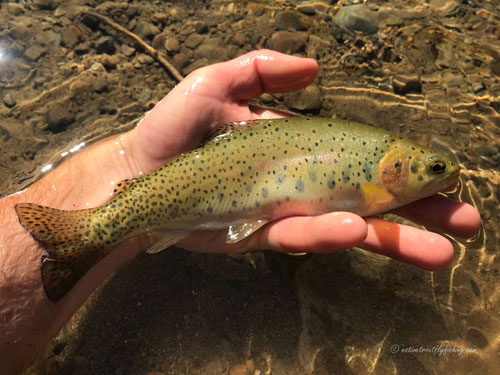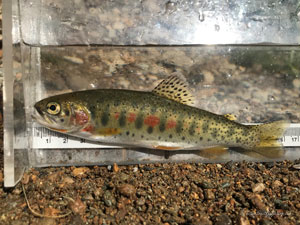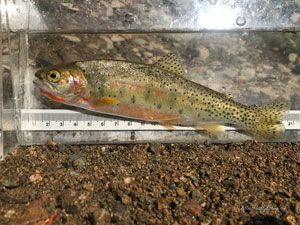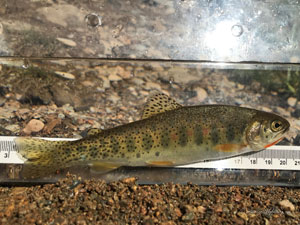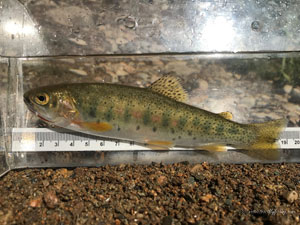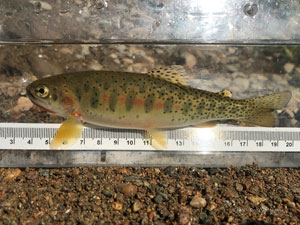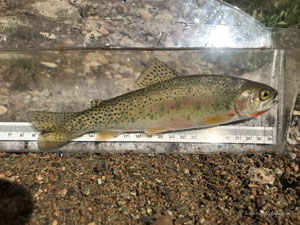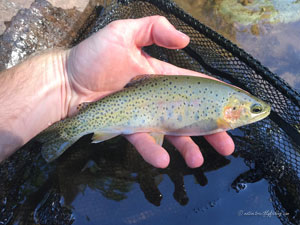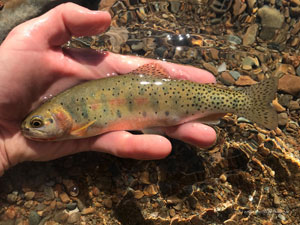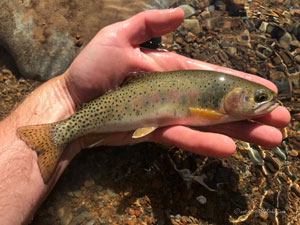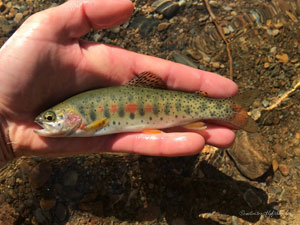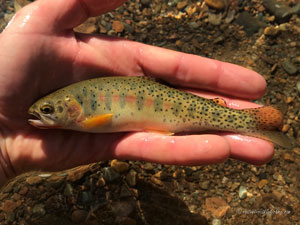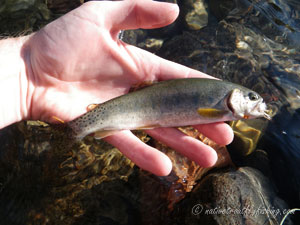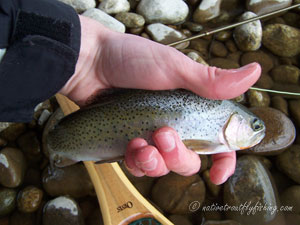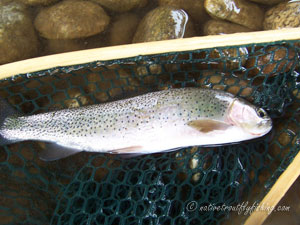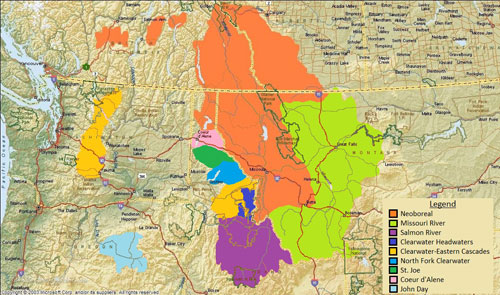Neoboreal Westslope Cutthroat
Oncorhynchus lewisi ssp.
A stream resident Neoboreal Westslope Cutthroat from a Montana stream.
Introduction
For years Westslope Cutthroat Trout were classified as a single subspecies (Behnke 1992, Behnke 2002, Trotter 2008) but genetic evidence shows high levels of diversity within the Westslope Cutthroat Trout genome, indicating the presence of nine distinct subspecies (Trotter et al. 2018). Of these nine subspecies, the Neoboreal Westslope Cutthroat Trout has the largest native range and are native to parts of the upper Columbia, Fraser and Saskatchewan watersheds in Washington, Idaho, Montana, British Columbia, and Alberta. There are several disjunct populations in the upper Fraser drainage of British Columbia that were initially classified as a distinct subspecies the Alpine Cutthroat Oncorhynchus clarki alpestris (Dymond 1931) but based on taxonomic characteristics and genetics these populations clearly align with the Neoboreal Cutthroat (Behnke 1992, Young et al. 2018). The Neoboreal Cutthroat are most closely related to the Missouri River Westslope Cutthroat Trout, to which there was a connection until the early 1900’s (Young et al. 2018).
Life History Information
Neoboreal Westslope Cutthroat Trout exhibit stream resident, fluvial (river migrant) and adfluvial (stream to lake migrant) populations. Stream resident populations of Neoboreal Westslope Cutthroat typically occur in the headwater of tributary streams, often above barrier falls. These fish mature at between two and five years of age and 6” to 10” (15 to 25 cm) (Johnson 1961, Behnke 2002). However, some individuals do mature earlier, and female stream resident Neoboreal Westslope Cutthroat appear to spawn for the first time at a size of between 4” to 6” (11 to 15 cm) and appear to spawn annually after their first spawning event (Janowicz et al. 2018, Carim et al. 2021). Nanako et al. (1992) showed that in small streams containing both Bull Trout and Neoboreal Westslope Cutthroat, the Cutthroat tended to be drift feeders while the Bull Trout obtained most of their food from the bottom. This study also showed that while the Bull Trout fed heavily on mayfly nymphs, the Westslope Cutthroat primarily ate terrestrial insects when they were available. Stream resident Cutthroat typically have small home ranges of < 164 feet (50 m), with home range size associated with the distance between pools and holding water (Cody et al. 2020). The maximum age for stream resident Neoboreal Westslope Cutthroat is generally around 5 to 6 years old, although fish up to 13 years old have been observed (Janowicz et al. 2018).
Fluvial (River Migratory) Form
Unlike stream resident fish, which spend their entire lives in tributary streams, fluvial fish migrate to larger rivers to feed and overwinter. Juvenile fluvial Neoboreal Westslope Cutthroat typically spend their first one to three years rearing in the lower portions of the tributary streams in which they were spawned prior to migrating to larger streams (Shepard et al 1984). Juveniles typically migrate out of tributaries from May-July and upon moving into a river, juvenile Cutthroat seek out deep pools or runs and migrate throughout the watershed to maximize foraging opportunities. Fluvial Neoboreal Cutthroat generally reach a maximum size of 22” (55 cm) and a maximum age of eight years old (Fraley and Shepard 2005, Muhlfeld et al. 2009). During the summer growing season these fish feed primarily on aquatic invertebrates or terrestrial invertebrates. While these Cutthroat will move to maximize foraging opportunities, they typical occupy relatively small home ranges during summer, with work on the Elk River in British Columbia showing that the typical home range was 3.9 miles (6.2 km) (Bennet 2004). Once fall sets in, Cutthroat begin congregating as they prepare to migrate upstream or downstream overwintering habitat. In larger river systems, fluvial Cutthroat prefer to overwinter in deep slow-moving pools with boulders or woody debris in them and generally remain in these pools until the water temperatures warm up to 45 to 50° F (7 to 10° C) in March (Jakober et al. 1998, Bennett 2004). Cutthroat in these pools become largely nocturnal during winter and will often hide in large wood debris or rock crevices during the day, only emerging at night and moving into shallower water (Jakober et al. 2000). In some watersheds such as the Blackfoot River in Montana, instead of seeking out mainstem pool habitat for overwintering, some fluvial Westslope Cutthroat move into spring fed tributary streams taking advantage of the constant flow and temperature during the coldest months of the year (Pierce et al. 2014).
Adult fluvial Neoboreal Westslope Cutthroat spawn during the spring (typically April to June) when runoff is the highest (Trotter 2008, Pierce et al. 2014). Spawning typically occurs in the lower reaches of tributary streams, but some fish also use mainstem or side channel habitat as spawning areas. For example, in the Ram River in Alberta about 22% of the fish used mainstem or side channel habitat for spawning (Brown and Mackay 1995). In general fish travel anywhere from 2 miles up 68 miles to (3 km to 110 km) upstream or downstream, over a period of about 10 days to reach their spawning grounds (Scmetterling 2001, Bennett 2004, Muhlfeld et al. 2009, Pierce et al. 2014). Upon reaching spawning tributaries the Cutthroat will hold off creek mouths waiting for peak flows for up to two weeks before moving upstream. Once in their spawning streams Cutthroat appear to select water about 5” (13 cm) deep in riffles or upstream of the tailouts of runs to dig their redds and spend about a month in the tributaries before moving back downstream to the river (Scmetterling 2000, Pierce et al. 2014). There appears to be high mortality between spawning events, and fish that do survive to spawner a second time do not appear to select the same spawning location as they choose on previous spawning runs (Scmetterling 2001). On average, females produce ~1500 eggs, which generally hatch after about 50 – 60 days, with fry generally emerging in July and remain in shallow nearshore areas or smaller tributaries throughout their first summer (Johnson 1961).
Adfluvial (Stream to Lake Migratory) Form
Adfluvial Neoboreal Westslope Cutthroat populations were historically widespread and occur in most large lakes across their native range, such as Flathead, Kootenay and Pend Oreille, as well as in as numerous smaller alpine lakes. Like fluvial populations adfluvial Neoboreal Westslope Cutthroat are born and rear in tributaries draining to lakes, where they typically spend the first two to three years of their life (Huston 1970, Shepard et al. 1984). However, one isolated population in Alberta exhibits a true lacustrine (lake dwelling) life history with adults documented spawning on shoals in the lake and with the fish spending their entire life in the lake (Trotter 2008). Juveniles may migrate into the lake over a board period, with fish in Lake Koocanusa in Montana documented entering the lake as early as March, although the majority entering in June and July with a second migration peak in September and October (Shepard et al. 1984). After entering the lake, young adfluvial fish typically forage in near shore areas (Bennett 2004). Due to their life history adfluvial Neoboreal Westslope Cutthroat are not known to reach especially large sizes and appear to have a maximum size of about 5 lbs. (2.25 kg). This is mainly because they rarely prey on other fish, a behavior that this thought to be attributed to the fact that Neoboreal Westslope Cutthroat have coevolved with two other highly predatory fish species, the Bull Trout and Northern Pikeminnow (Behnke 2002). Instead, the majority of adfluvial Neoboreal Westslope Cutthroat's diet comes from zooplankton, and aquatic and terrestrial insects (Trotter 2008). During winter adfluvial Cutthroat feeding slows significantly with the majority of their diet in the lake composed of chironomids (Shepard et al. 1984). To counter poor winter foraging conditions in many lakes, adfluvial Westslope Cutthroat may overwinter instead rivers, with fish starting to move into the rivers in October. For fish that due overwinter in lakes, they typically inhabit surface waters during fall, winter, and spring the Cutthroat, but tend to move into deeper water in the summer to seek out temperatures in the preferred range of 49 to 55 °F (9.5 to 12.9 °C) (Shepard et al. 1984). Spawners that overwinter in the lakes typically begin their spawning migrations in March and April. Some populations make long migrations to reach their spawning grounds and fish from Flathead Lake are known to travel as far as 132 miles (212 km) to reach spawning tributaries (Trotter 2008). Spawning of an adfluvial population in Mud Lake, Montana was observed between April 21 and June 15, with upstream migration into spawning tributaries occurring with spring runoff (Johnson 1961). Post-spawning mortality is generally high and ranged from 27% to 60% in a tributary to Lake Koocanusa, Montana (Huston et al. 1984). After spawning surviving adfluvial Cutthroat migrate back downstream to the lakes they rear in throughout the summer.
Status
Neoboreal Westslope Cutthroat have been negatively across much of their native range, although stronghold populations such as the South Fork Flathead River still exist. Due to the decline of Westslope Cutthroat including the Neoboreal subspecies in the United States, the species was proposed to be listed as threatened under the Endangered Species Act (ESA) (USFWS 1996). Although the petition to list Westslope Cutthroat was declined, many populations remain at risk of extinction (USFWS 2003, Shepard 2005). Neoboreal Westslope Cutthroat populations have also been impacted in Canada and today populations in Alberta are listed as threatened and populations in British Columbia are classified as a species of special concern (COSEWIC 2006). The cause of the decline of Neoboreal Westslope Cutthroat varies from watershed to watershed, but the primary drivers have been the introduction of non-native species, habitat destruction and over harvest.
The introduction of non-native species has perhaps been the single greatest factor leading to the decline of the Westslope Cutthroat. Westslope Cutthroat are impacted by introduced species by predation, competition, and hybridization. In small streams introduced Brook Trout which hatch earlier than the Cutthroat have a competitive advantage and often completely replace the native Cutthroat. According to Behnke (2002) the introduction of Kokanee, Lake Trout and Lake Whitefish into the large lakes in the Columbia River watershed has led to a 90% or more decline in the Westslope Cutthroat populations inhabiting these lakes. Hybridization presents one of the greatest threats to Neoboreal Westslope Cutthroat. Below Cabinet Dam on the Clark Fork River, hybridization with hatchery Rainbow Trout appears to be occurring at low levels and recent genetic analysis indicated that approximately 15% of the population had some level of hybridization with Rainbow Trout (Adams et al. 2021). In some locations such as Rock Creek in the Clark Fork drainage Westslope Cutthroat populations have managed to maintain reproductive isolation from non-native Rainbow Trout. While the mechanisms for this reproductive isolation are still being evaluated, a study on the Flathead River, found that introduced Rainbow Trout spawn earlier than native Cutthroat. Generally, Rainbow Trout spawn in April and May as spring runoff is increasing, while Cutthroat spawn May and June during peak runoff or as runoff begins to subside. Westslope Cutthroat also tend to spawn further upstream often in headwater locations reducing the potential for hybridization (Muhlfeld et al. 2009). Despite this there is enough overlap between the two species that hybridization occurs at many locations and reduces potential for fluvial populations Cutthroat to utilize lower elevation sites for spawning without being exposed to hybridization with Rainbow Trout. Variation in annual flow and temperature associated with climate change has led to increased hybridization, with high flow years resulting in increased overlap in spawning between Rainbow Trout and Cutthroat. There is evidence that hybridization is increasing in the Flathead watershed and, hybridization was detected at 57% of the sites sampled between 1998 and 2001 (Hitt et al. 2003, Muhlfeld et al. 2009).
The Clark Fork and Flathead River watersheds act as a case study of many of the threats facing the Neoboreal across their native range. As indicated, hybridization with Rainbow Trout and competition with Brook Trout are common threats in the watershed. Brown Trout have also been introduced to the Clark Fork River and similar to Brook Trout out compete as well as prey on juvenile Cutthroat in the watershed. Northern Pike have also been introduced to the watershed and Mulfeld et al. (2008) indicated that Northern Pike are estimated to consume 13,000 Cutthroat from the Flathead River drainage annually. Similarly, Lake Trout were introduced to many of the large lakes in the Flathead River watershed and prey significant on Cutthroat and present a threat to the long-term persistence of adfluvial populations (D'Angelo 2010). For fluvial Neoboreal Westslope Cutthroat populations, interconnected habitat is essential to allow fish to move between overwinter, spawning, and foraging areas. As such poorly designed road crossings and irrigation structures and adversity influence fluvial populations (Pierce et al. 2007). Additionally, there are several dams in the basin, which block migration and inhibit the expression and connectivity of the fluvial life history forms. There has also been extensive mining in the upper part of the basin, especially in the area around Butte and Anaconda Montana. A large part of the upper Clark Fork mainstem is now a superfund cleanup site due to high levels heavy metal and other contaminant loads. The while progress is being made in cleaning up the upper Clark Fork River, however heavy metal loads continue to negatively impact Cutthroat survival and often reach lethal levels during runoff events (Mayfield 2013). However, even though Neoboreal Westslope Cutthroat are nowhere near as abundant as they once were in the Clark Fork and Flathead watersheds, there still are some strongholds populations such as the South Fork of the Flathead River, MT remain safe havens for these beautiful trout. Thanks to restoration efforts and improved management practices have improved in recent decades and Neoboreal Cutthroat are starting to show signs of recovery in parts of the basin.
Description
The Neoboreal Westslope Cutthroat Trout are similar in appearance to other Westslope Cutthroat subspecies. The coloration on the backs of these fish is typically a greenish-olive, bronze or even grayish color. The side of these fish range from a grayish color to tan or bronze and the bellies and gill plates typically show a peach to bright orange color and this same color may be found along the lateral line, often between the parr marks on smaller individuals. In stream resident populations the 8 to 11 elliptical shaped parr marks are often retained into maturity. Spots are generally irregularly shaped, small to medium sized and concentrated towards the posterior region of the body and along the back with relatively few spots found below the lateral line in the middle of the body. Their fins are a yellow to orange or peachy color and spots are typically found on the dorsal, adipose and caudal fins.
Stream Resident Form
Click on images to view a larger picture
Fluvial Form
Click on images to view a larger picture
Native Range
Above: A map of the native range of the Westslope Cutthroat trout. Data Sources: Behnke (2002), Trotter (2008) and Young et al. (2018). Below: A map of the native range of the Neoboreal Westslope Cutthroat Trout.
References
Adams, B., M. Piteo, J. Von Bargen. 2021. Genetic analysis of native salmonids from the Lake Pend Oreille and Clark Fork River system, Idaho and Montana. Annual Report for Calendar Year 2020. Avista Corporation. Noxon, Montana.
Behnke, R. J. 1992. Native trout of western North America. American Fisheries Society Monograph 6. American Fisheries Society, Bethesda, Maryland.
Behnke, R. 2002. Trout and Salmon of North America. Chanticleer Press, New York.
Bennett, S. 2004. Accounts and measures for managing identified wildlife in British Columbia - Westslope Cutthroat Trout (Oncorhynchus clarki lewisi). 10.13140/2.1.1755.1684.
Brown, R.S. and W.C. Mackay. 1995. Spawning ecology of cutthroat trout (Oncorhynchus clarki) in the Ram River, Alberta. Canadian Journal of Aquatic and Fisheries Sciences 52: 983-992.
Carim, K.J., S. Relyea, C. Barfoot, L.A. Eby, J.A. Kronenberger, A.R. Whiteley and B. Larkin. 2021. Ultrasound imaging identifies life history variation in resident Cutthroat Trout. PLOS ONE 1-17. https://doi.org/10.1371/journal.pone.0246365
Cody, H., A. Lahr and L. Eby. 2020. Westslope Cutthroat Trout summer movement in western Montana headwater streams. University of Montana Conference on Undergraduate Research (UMCUR). 7. https://scholarworks.umt.edu/umcur/2020/lifesciences_poster/7
COSEWIC. 2006. COSEWIC assessment and update status report on the westslope cutthroat trout Oncorhynchus clarkii lewisi (British Columbia population and Alberta population) in Canada. Committee on the Status of Endangered Wildlife in Canada. Ottawa. Vii + 67pp. www.sararegistry.gc.ca/status_e.cfm).
Dymond, JR. 1931. Description of two new forms of British Columbia Trout. Contributions to Canadian Biology and Fisheries 6(1): 391-395.
COSEWIC. 2006. COSEWIC assessment and update status report on the westslope cutthroat trout Oncorhynchus clarkii lewisi (British Columbia population and Alberta population) in Canada. Committee on the Status of Endangered Wildlife in Canada. Ottawa. Vii + 67pp. www.sararegistry.gc.ca/status_e.cfm).
D'Angelo, V.S. 2010. Factors influencing the distribution of Bull Trout and Westslope Cutthroat Trout west of the continental divide in Glacier National Park. Masters Thesis. University of Montana, Missoula, Montana.
Fraley, J. and B.B. Shepard. 2005. Age, growth, and movements of westslope cutthroat trout, Oncorhynchus clarki lewisi, inhabiting the headwaters of a wilderness river. Northwest Science 79(1): 12-21.
Hitt, N.P., C.A. Frissell, C.C. Muhlfeld and F.W. Allendorf. 2003. Spread of hybridization between native Westslope cutthroat trout, Oncorhynchus clarki lewisi, and nonnative rainbow trout, Oncorhynchus mykiss. Canadian Journal of Aquatic and Fisheries Sciences 60: 1440-1451.
Huston, J.E. 1970. Investigations on Hungry Horse Reservoir, Montana. Montana Fish and Game Department. Progress Report, Project No. F-34-R-3. 11 p.
Huston, J., B. May, McMullin S.L. and P. Hamlin. 1984. Lake Koocanusa post-impoundment studies, final report. Montana Department Fish, Wildlife and Parks, Contract No. DACW 66-79-C-0077, report to United States Army Corps of Engineers, Seattle District, Seattle, Washington.
Jakober, M.J., T.E. McMahon, R.F. Thurow and C.G. Clancy. 1998. Role of stream ice on fall and winter movements and habitat use by bull trout and cutthroat trout in Montana headwater streams. Transactions of the American Fisheries Society 127:223–235.
Jakober, M.J., T.E. McMahon and R.F. Thurow. 2000. Diel habitat partitioning by bull charr and cutthroat trout during fall and winter in Rocky Mountain streams. Environmental Biology of Fishes 59: 79-89.
Janowicz, M.E., W. Zalachowski, A. Rybczyk, S. Dalton, E. Fernandes and N.F. Fontoura. 2018. Age, growth and reproductive biology of threatened westslope cutthroat trout Oncorhynchus clarkii lewisi inhabiting small mountain streams. Journal of Fish Biology 93(5): 874-886. https://doi.org/10.1111/jfb.13792
Johnson, H.E. 1961. Observations on the life history and movements of Cutthroat Trout (Salmo clarki) in the Flathead River drainage, Montana. Masters Thesis. Montana State College, Bozeman, Montana.
Mayfield, M.P. 2013. Limiting factors for trout populations in the upper Clark Fork River superfund site, Montana. Masters Thesis. University of Montana, Missoula, Montana.
Mayhood, D.W. 2000. Provisional evaluation of the status of westslope cutthroat trout in Canada. Proceedings of Biology and Management of Species and Habitats at Risk, Kamloops, B.C., 15–19 Feb. 1999: 579-586.
Muhlfeld, C. C., D. H. Bennett, R. K. Steinhorst, B. Marotz, and M. Boyer. 2008. Using bioenergetics modeling to estimate consumption of native juvenile salmonids by nonnative Northern Pike in the upper Flathead River system. North American Journal of Fisheries Management 28(3): 636-648.
Muhlfeld, C.C., T.E. McMahon, D. Belcer and J.L. Kershner. 2009a. Spatial and temporal spawning dynamics of native westslope cutthroat trout, Oncorhynchus clarkii lewisi, introduced rainbow trout, Oncorhynchus mykiss, and their hybrids. Canadian Journal of Aquatic and Fisheries Sciences 66: 1153-1168.
Nakano, S., K.D. Fausch, T. Furukawa-Tanaka, K. Maekawa and H. Kawanabe. 1992. Resource utilization by Bull Char and Cutthroat Trout in a mountain stream in Montana, USA. Japanese Journal of Ichthyology 39(3): 211-217.
Pierce, R.W., R.B. Aasheim and C.S. Podner. 2007. Fluvial Westslope Cutthroat Trout movements and restoration relationships in the Upper Blackfoot basin, Montana. Intermountain Journal of Sciences 13(2-3): 72-85.
Pierce, R., C. Podner, T. Wendt, R. Shields, and K. Carim. 2014. Westslope Cutthroat Trout movements through restored habitat and coanda diversions in the Nevada Spring Creek complex, Blackfoot basin, Montana. Transactions of the American Fisheries Society 143:230–239.
Schmetterling, D.A. 2000. Redd characteristics of fluvial Westslope Cutthroat Trout in four tributaries to the Blackfoot River, Montana. North American Journal of Fisheries Management 20: 776-793.
Schmetterling, D.A. 2001. Seasonal movements of fluvial westslope cutthroat trout in the Blackfoot River drainage, Montana. North American Journal of Fisheries Management 21: 507-520.
Shepard, B.B., K.L. Pratt and P.J. Graham. 1984. Life histories of westslope cutthroat and bull trout in the upper Flathead River basin, Montana. Environmental Protection Agency, Region VIII, Water Division, Denver Colorado. 85 p.
Shepard, B. B., B. E. May, and W. Urie. 2005. Status and conservation of Westslope Cutthroat Trout within the western United States. North American Journal of Fisheries Management 25: 1426–1440.
Taylor, E.B., M.D. Stamford and J.S. Baxter. 2003. Population subdivision in westslope cutthroat trout (Oncorhynchus clarki lewisi) at the northern periphery of its range: evolutionary inferences and conservation implications. Molecular Ecology 12: 2609–2622.
Trotter, P., B. McMillan, N. Gayeski, P. Spruell and A. Whiteley. 1999. Genetic and phenotype catalog of native resident trout of the interior Columbia River basin: populations of the of the Pend Oreille, Kettle, and Sanpoil River Basins of Colville National Forest. Bonneville Power Administration, Portland, OR.Project No. 1998-02600, 188 electronic pages, (BPA Report DOE/BP-00004575-1)
Trotter, P. 2008. Cutthroat: Native Trout of the West. Second Edition. University of California Press, Berkley, CA.
Trotter, P., P. Bisson, B. Roper, L. Schultz, C. Ferraris, G.R. Smith and R.F. Stearley. 2018. A special workshop on the taxonomy and evolutionary biology of cutthroat trout. Pages 1-31 in Trotter P, Bisson P, Schultz L, Roper B (editors). Cutthroat Trout: Evolutionary Biology and Taxonomy. Special Publication 36, American Fisheries Society, Bethesda, Maryland.
USFWS. 1996. Endangered and threatened wildlife and plants; notice of final decision on identification of candidates for listing as endangered or threatened. FR 61:65581-64485.
USFWS. 2003. Endangered and threatened wildlife and plants: reconsidered finding for an amended petition to list the Westslope Cutthroat Trout as threatened throughout its range. FR 68:46989-47009.
Young, M.K., K.S. McKelvey, T. Jennings, K. Carter, R. Cronn, E.R. Keeley, J.L. Loxterman, K.L. Pilgrim and M.K. Schwartz. 2018. The phylogeography of westslope cutthroat trout. Pages 261-301 in Trotter P, Bisson P, Schultz L, Roper B (editors). Cutthroat Trout: Evolutionary Biology and Taxonomy. Special Publication 36, American Fisheries Society, Bethesda, Maryland.
Contact
Feel free to contact me if you have any questions or comments
Neoboreal Westslope Cutthroat Trout Links
My Neoboreal Westslope Cutthroat Trips
Washington Department of Fish and Wildlife - Westslope Cutthroat Trout
Idaho Department Fish and Game - Westslope Cutthroat Trout
Montana Fish, Wildlife and Parks - Westslope Cutthroat Trout
Glacier National Park - Fishing
Waterton Lakes National Park - Fishing
Idaho Panhandle National Forests
Beaverhead-Deerlodge National Forest
Helena-Lewis and Clark National Forest
Western Native Trout Initiative - Westslope Cutthroat Trout
Native Trout Links
Truchas Mexicanas' - Native Trout of Mexico
Balkan Trout Restoration Group
Trout and Seasons of the Mountain Village - About Japanese Trout
Western Native Trout Challenge
California Heritage Trout Challenge
Fly Fishing Blogs
Dave B's Blog: Fly Fishing for Native Trout
The Search for Native Salmonids
Conservation Links
Western Native Trout Initiative
Fly Fishing Links
Fishing Art Links
Americanfishes.com - Joseph R. Tomelleri
